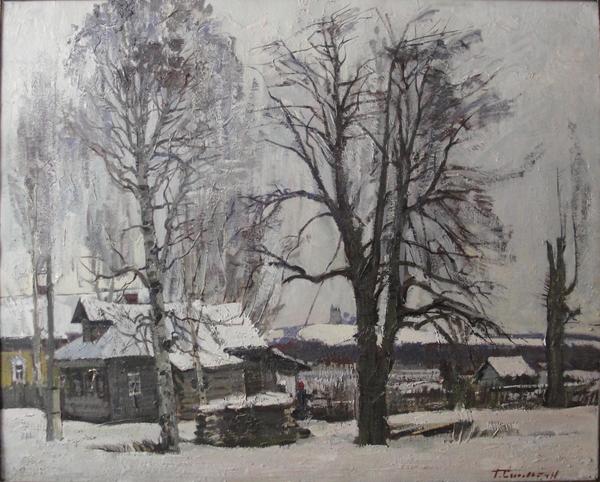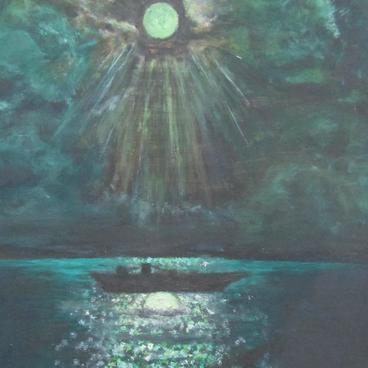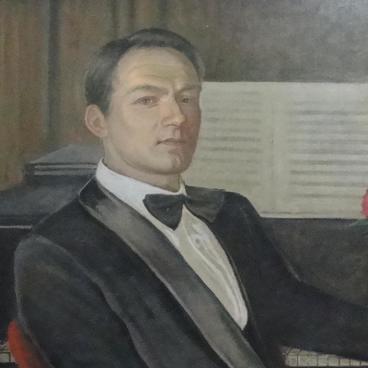Georgy Andreevich Sysolyatin is one of the best painters of the Russian classical school in the second part of the 20th century. A parallel is often drawn between his canvases and those of the ‘evocative landscape’ master, Isaac Levitan. Sysolyatin’s works are notable for deep vivid colours and the powerful temperamental style of painting.
In the 1960s Ryumnikovo village in Yaroslavl region became a subject of works for quite a few painters. The artists were attracted by its remoteness from big cities, as well as the pristine beauty of its lake, oak forests and meadows. Painter Gely Korzhev was the first to buy a house here. Then Sysolyatin followed his friend’s example. Vasily Vasilyevich Pochitalov — their mentor and an associate professor of Moscow Surikov Institute — also had a summer house in this village.
Landscapes were Georgy Susolyatin’s favourite genre, even though quite a few pieces of his artistic legacy are portraits, interior scenes and still-lifes. The painting Winter in Ryumnikovo, featuring winter nature in the village, was created in plastique style — the art of conveying emotions through movement. What is special about this technique is that it does not come with talent, but from countless repetitions. As a result, the painting turned out very realistic, three-dimensional, with strong expressive lines.
To the spectator the canvas opens a view of a little piece of a village street with old tumble-down houses. At the forefront there are dark bare trees with some birds’ nests. Uneven snow covers yards, premises and roofs. In the bottom right corner, the painter’s signature is clearly visible.
The colours are deepened to the maximum, however myriads of colouristic nuances are visible in that dark palette. The painter’s works stand out for their delicate colour craftmanship. The artist manages to create a sense of reality in the spectator, showing the movement of the forces of nature, which triggers associations with classical music.
Georgy Sysolyatin was born in Bashkir city of Blagoveshchensk in 1936. He learned to paint from the acknowledged masters of that period: Vasily Pochitalov, Fedor Antonov, Vasily Khvostenko. In 1963, Georgy Sysolyatin graduated from the capital’s Textile Institute, and only a year later was accepted as a member of the Union of Artists of the USSR. This painter’s work played a significant role in the art industry — his artworks were honoured with thirty awards at the USSR and national exhibitions. In 1990’s the artist did a lot of teaching and lecturing in his homeland, and travelled abroad to Korea and India to share his experience. He died in 2010 and was buried in Moscow.
In the 1960s Ryumnikovo village in Yaroslavl region became a subject of works for quite a few painters. The artists were attracted by its remoteness from big cities, as well as the pristine beauty of its lake, oak forests and meadows. Painter Gely Korzhev was the first to buy a house here. Then Sysolyatin followed his friend’s example. Vasily Vasilyevich Pochitalov — their mentor and an associate professor of Moscow Surikov Institute — also had a summer house in this village.
Landscapes were Georgy Susolyatin’s favourite genre, even though quite a few pieces of his artistic legacy are portraits, interior scenes and still-lifes. The painting Winter in Ryumnikovo, featuring winter nature in the village, was created in plastique style — the art of conveying emotions through movement. What is special about this technique is that it does not come with talent, but from countless repetitions. As a result, the painting turned out very realistic, three-dimensional, with strong expressive lines.
To the spectator the canvas opens a view of a little piece of a village street with old tumble-down houses. At the forefront there are dark bare trees with some birds’ nests. Uneven snow covers yards, premises and roofs. In the bottom right corner, the painter’s signature is clearly visible.
The colours are deepened to the maximum, however myriads of colouristic nuances are visible in that dark palette. The painter’s works stand out for their delicate colour craftmanship. The artist manages to create a sense of reality in the spectator, showing the movement of the forces of nature, which triggers associations with classical music.
Georgy Sysolyatin was born in Bashkir city of Blagoveshchensk in 1936. He learned to paint from the acknowledged masters of that period: Vasily Pochitalov, Fedor Antonov, Vasily Khvostenko. In 1963, Georgy Sysolyatin graduated from the capital’s Textile Institute, and only a year later was accepted as a member of the Union of Artists of the USSR. This painter’s work played a significant role in the art industry — his artworks were honoured with thirty awards at the USSR and national exhibitions. In 1990’s the artist did a lot of teaching and lecturing in his homeland, and travelled abroad to Korea and India to share his experience. He died in 2010 and was buried in Moscow.



